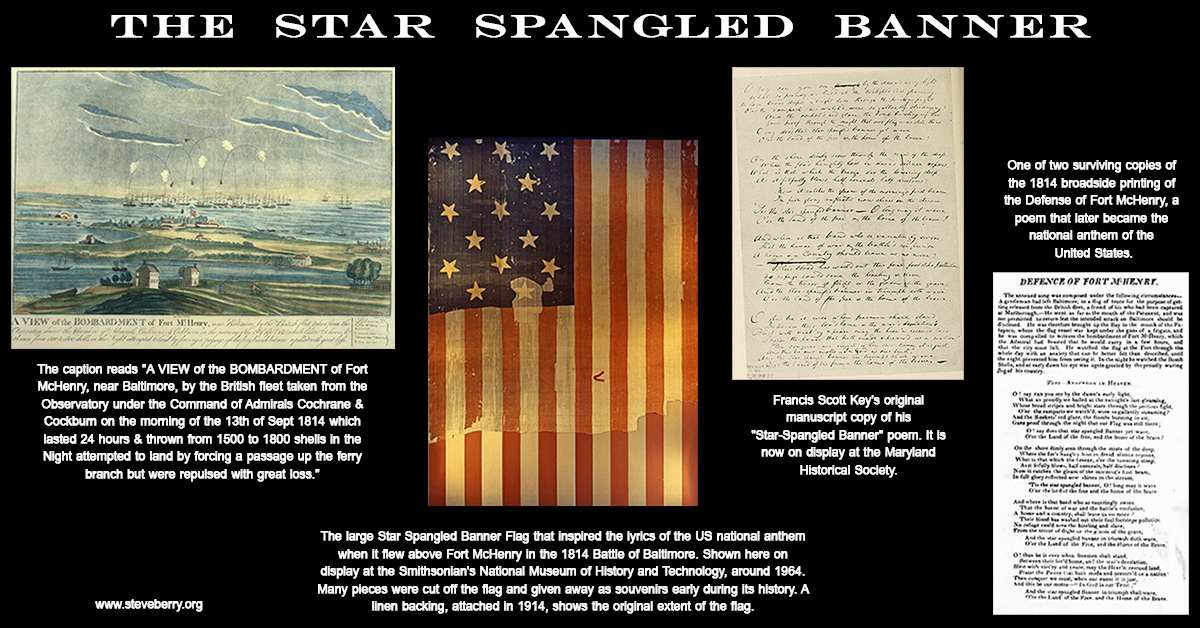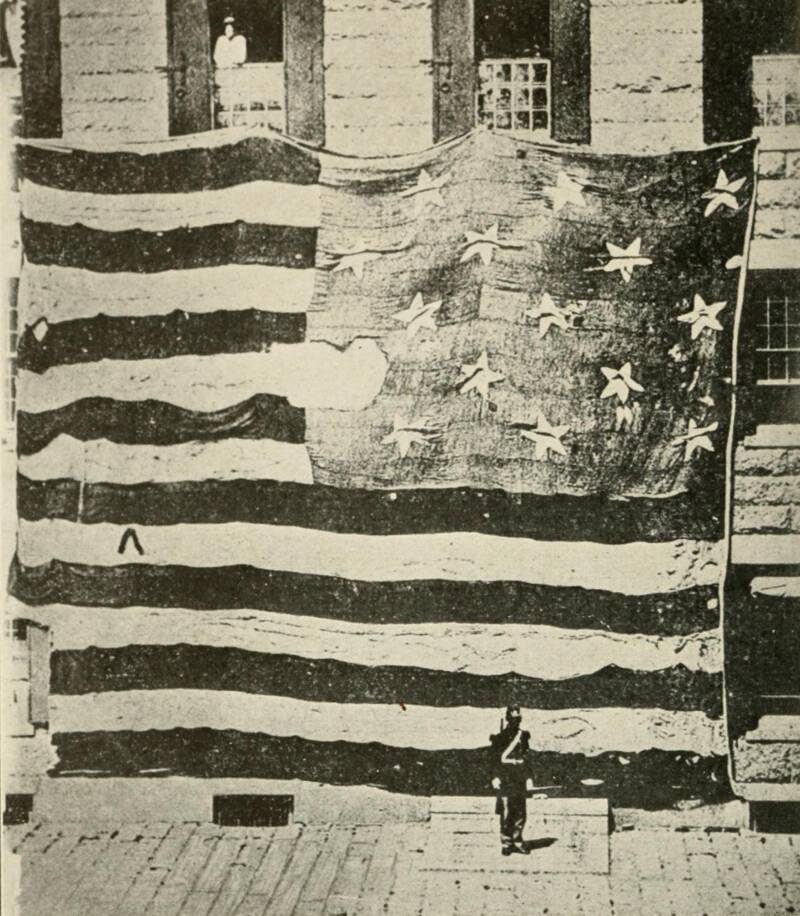
Star Spangled Banner As You've Never Heard It
LISTEN: https://www.youtube.com/watch?v=YaxGNQE5ZLA
The Accurate Story Behind the Star Spangled Banner
LISTEN: https://www.youtube.com/watch?v=6hZe8CPGA1E



-
On the night of September 13-14 of 1814, Francis Scott Key found himself aboard a British ship being held behind enemy lines. The British were attempting to take Fort McHenry, the fort that sits at the mouth of Baltimore Harbor.
Key had gone to Baltimore to negotiate the release of his friend, Dr. William Beanes, who had been taken prisoner by the British. He was accompanied by Colonel John Skinner and together, they were successful in negotiating the release. However, the British would not allow the men to leave the ship as they had overheard plans for the bombardment of Fort McHenry. The three men watched the attack from a ship about eight miles away. After about 25 hours, the British gave up as they were unable to destroy the fort. The men were finally released the evening of September 16.
When Key saw the American flag still flying over the fort at daybreak on September 14, he wrote a few lines in tribute to what he had witnessed. He finished the poem after they were released and titled it “Defence of Fort M’Henry.” Key’s brother-in-law, Judge J.H.Nicholson, set the poem to the popular melody "The Anacreontic Song", by English composer John Stafford Smith. He then took the poem to a printer who anonymously printed the first known broadside on September 17. A few weeks later, Baltimore actor Ferdinand Durang sang it at Captain McCauley's tavern, calling the song the “Star-Spangled Banner.” It was an immediate success.
"The Star-Spangled Banner" was recognized for official use by the United States Navy in 1889 and was made the national anthem by a congressional resolution on March 3, 1931.
INTRODUCTION
On September 14, 1814, Maryland lawyer and slaveholder Francis Scott Key wrote "The Star-Spangled Banner," which became America's national anthem more than a century later. But the full story is much more complicated.
As the national anthem of the United States, “The Star-Spangled Banner” is a ubiquitous part of American life. It plays before everything from military ceremonies to football games. But who wrote “The Star-Spangled Banner,” and why does it matter today?
Even though most Americans know the song, the history behind it remains a mystery to many. Just for starters, the fact that it’s only been America’s national anthem for a fraction of U.S. history might come as a shock.
“The Star-Spangled Banner” was penned by Francis Scott Key, a 19th-century lawyer who dabbled in poetry. Inspired by the Battle of Baltimore in 1814, Keys was so moved at the American resilience he saw that he couldn’t wait to write the lyrics — and scribbled them on the back side of a letter.
Despite the instant popularity of the song, it took more than a century after it was written for it to be officially recognized as the national anthem. And ever since its creation, it’s been steeped in controversy, from its racist lyrical content to its anti-British sentiments.

The flag that flew over Fort McHenry and inspired the national anthem.
-
HISTORY
n 1814, America was in its second year of war against the British in the War of 1812. The city of Washington, D.C. had sustained great damage, including the burning down of the Capitol. Even the President’s house had been set on fire, but was saved before too much damage was done. (The burnt walls were easily repaired and the damage was covered by a heavy coat of white paint. Ever since then, the house has been called the White House.) Soon the British fleet would prepare to move against the city of Baltimore, too. But first they had to destroy Fort McHenry which guarded the city. The largest British ships sailed up Chesapeake Bay and anchored opposite the Fort.
Francis Scott Key was a lawyer and a volunteer soldier in Baltimore at that time. A friend of his, Dr. William Beanes, was captured mistakenly by the British who thought that he was a soldier. Francis was determined to rescue his friend and so he approached the British in the harbor under a flag of truce. He brought with him a letter from President Madison which stated that the doctor was indeed a private citizen and should be released.
After considering the facts, the British Admiral agreed to release Dr. Beanes. Unfortunately for Francis and the doctor however, the British were preparing to open attack on Fort McHenry just at that moment. They were afraid if they let the two men go, they would have time to warn those defending the Fort. The Americans were allowed to return to their own boat, but had to give their word that they would not return to shore. Francis could see the American flag flying over Fort McHenry from his ship. All day he watched it streaming gallantly in the breeze. It is said the British told him to remember it well at sunset, for it would not be there in the morning.
When the firing began, it was dark. Francis and the doctor could do nothing but wait and watch. Whenever a bombshell exploded or rocket burst high in the air, the glare from the explosion gave off enough light for them to be able to see the flag still flying over the Fort. They did not know whether it would still be there in the morning.
The firing stopped and started through the night, but suddenly the British firing ceased completely. There were no more flashes of light by which the Fort could be seen even with the use of field glasses. Even when the sun began to rise, the light was gray and an early-morning blanket of fog hid the shore. When at last the fog did rise, Francis saw that “the flag was still there” over the Fort.
Overjoyed, he cried out, “Oh say! Can you see?” So overcome with the emotion of the moment, he was compelled to write his feelings down in verse. As the British pulled out of Chesapeake Bay, he continued to write the opening lines of his now famous anthem.
Within days, his poem was known all over the city. It was also apparent to many that the new words fit perfectly to a song that was very popular in America at the time, “To Anacreon in Heaven.” (This was a song that was written in England by John Stafford Smith in the 18th century and had been “borrowed” often by poets and lyricists.) Before long, people all over the country were singing the new song. In less than a week, it had reached as far as New Orleans – quite an accomplishment in those days! All of America had taken the song to heart.
For over a hundred years, Americans sang “The Star-Spangled Banner” with patriotic fervor and pride. But it wasn’t until March 3, 1931, that a law was passed making it the official national anthem.
The “Star-Spangled Banner” that Francis Scott Key wrote about that memorable night had fifteen stars and fifteen stripes for the fifteen states that were then in the Union. (The stripes were later changed to thirteen in honor of the thirteen original colonies, with a star being added for each state as it joined the Union.) The actual flag that inspired Francis is currently in the Smithsonian Institution’s National Museum in Washington, D.C. It is 33 feet long and 27 feet wide. There are eleven holes in it from British fire – one very large one near the center from a bombshell. There is also a corner missing because one wounded soldier who had helped defend the Fort asked that he be buried with a piece of the “Star-Spangled Banner.”